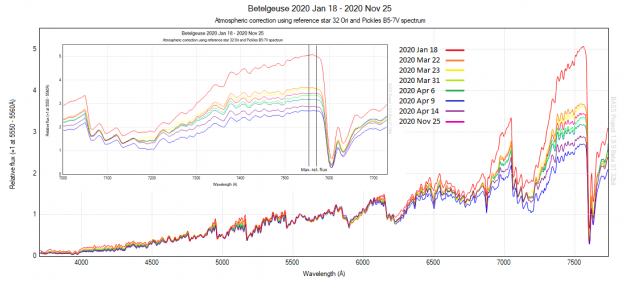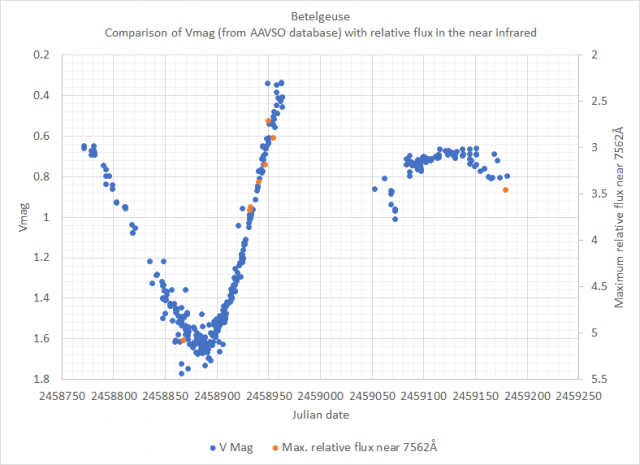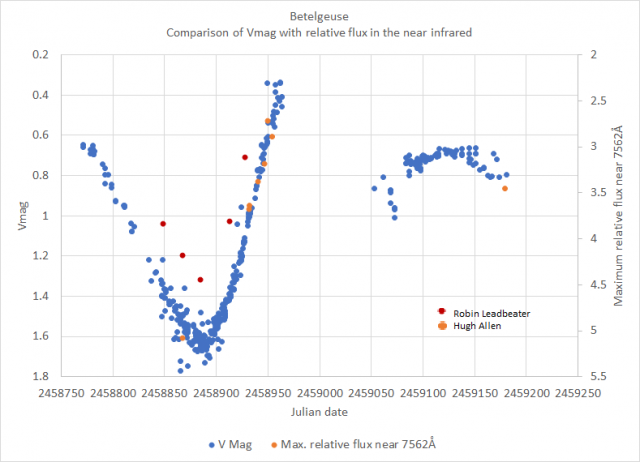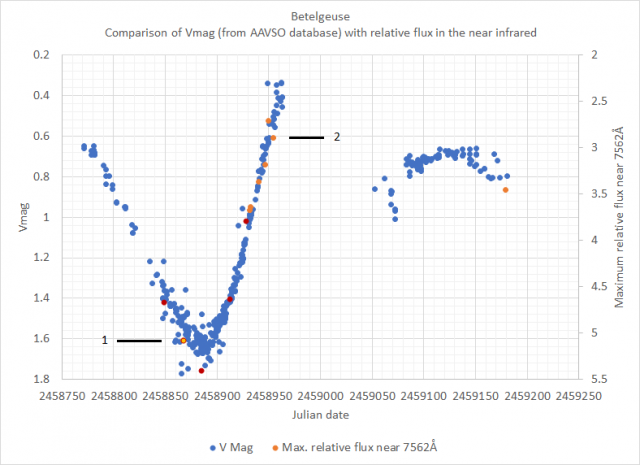› Forums › Variable Stars › VSS Circular 186 now available
- This topic has 8 replies, 4 voices, and was last updated 5 years, 1 month ago by
 Hugh Allen.
Hugh Allen.
-
AuthorPosts
-
29 November 2020 at 4:46 pm #574805
 Jeremy ShearsParticipant
Jeremy ShearsParticipantBAA VSS Circular 186 for 2020 December is now available for download here.
Many thanks to all our contributors and to Gary Poyner for editing it.
Best regards,
Jeremy ShearsDirector, BAA Variable Star Section
6 December 2020 at 11:43 pm #583474 Hugh AllenParticipant
Hugh AllenParticipantMark Kidger’s interesting article on the possibility for another deep fade of Betelgeuse coincided with my restarting spectroscopic observations (unfortunately only one break in the clouds so far here in the southwest in the last few weeks). The deep visual fade and rebrightening of Betelgeuse at the beginning of this year was accompanied by the reverse change in relative brightness in the near infrared (I think there was an earlier thread on the forum about this but I couldn’t seem to find it). This could be seen in my Alpy 600 spectra corrected for instrument response and atmospheric effects. I’ve tried to approximate this change by measuring the maximum relative flux as far into the infrared as my combination of Alpy 600 and Atik 314L camera will allow, in the region 7555 – 7565Å:

A comparative plot of the Vmag data from the AAVSO database along with this maximum relative flux in the near infrared gives the following:

I’d be interested in any feedback on this methodology. And it will be interesting to see how the two characteristics evolve over the next few months. Could the evolution in the near infrared depend on the casue of the fade (pulsation, starspot or dust?)
7 December 2020 at 9:06 am #583476 Jeremy ShearsParticipant
Jeremy ShearsParticipantNice work Hugh.
There is also a paper by Mark Kidger on Betelgeuse in the December Journal.
The original Betelgeuse Forum thread you mentioned is here.
7 December 2020 at 9:30 am #583477 Dr Andrew SmithParticipant
Dr Andrew SmithParticipantOne issue with relative intensity spectra in that where you place the normalisation region significantly effects the plots.
In effect you force the changes to be other than at that point. I don’t think the is a simple solution but requires going to absolute flux as described by David Boyd.
Regards Andrew
7 December 2020 at 12:41 pm #583478 Robin LeadbeaterParticipant
Robin LeadbeaterParticipantI think it is still valid though. Similar to a colour index, sort of (V-I)
Cheers
Robin
7 December 2020 at 1:34 pm #583480 Robin LeadbeaterParticipant
Robin LeadbeaterParticipantThe amateur spectroscopic monitoring was very extensive and as far as I know remains untapped by professionals. It would be interesting to know how our data fits the various models.
Cheers
Robin
7 December 2020 at 4:03 pm #583481 Dr Andrew SmithParticipant
Dr Andrew SmithParticipantNot sure about that as both V and I can vary and one is not pinned. In this case it may not be a problem as the depths of the bands clearly varies. However, it does concern me in general when continuum changes are significant as with my flare spectra.
Regards Andrew
7 December 2020 at 6:18 pm #583483 Robin LeadbeaterParticipant
Robin LeadbeaterParticipantV-I is a ratio though so should be independent of the actual flux under some scenarios eg partial obscuration by a completely opaque medium or by one which semi-transparent but absorbs equally at all wavelengths. We can therefore rule out these scenarios based on this. I agree though for scenarios where there is an additive effect eg starspots (or like your flares) the absolute magnitudes need to be considered to separate out the two components. Fortunately there is plenty of V mag data and the spectra cover the full passband so the spectra could be converted to absolute magnitude
8 December 2020 at 12:01 am #583486 Hugh AllenParticipant
Hugh AllenParticipantThanks for your feedback Andrew, and Robin as well. By normalising the relative flux near the centre of the V-band filter, I wondered if the changes in the relative flux in the near IR could then be monitored in a useful way compared to changes in the observed V magnitude (essentially a way of quantifying changes in the shape of the spectrum as the visual magnitude varies). But I can see some of the dangers, not least the initial process of corrrecting the shape of the spectrum for atmospheric effects. In the BAA database, Robin has a number of Alpy 600 spectra of Betelgeuse on which I made the same analysis:

There is an offset between our two methods of atmospheric correction. However the difference should just be a constant factor which can be best estimated from our almost simultaneous observations on JD 2458867.4 (2020 Jan 18), marked as point 1 in the adjusted chart below which shows all of the points from Robin’s data adjusted by the same factor. Once adjusted both our data follows a consistent trend. Point 2 is very interesting. It was my last observation of Betelgeuse on JD 2458954.3 (2020 Apr 14) before it disappeared into twilight and shows a significant increase in the relative intensity in the near IR even though the V mag was also continuing to increase:

-
AuthorPosts
- You must be logged in to reply to this topic.
